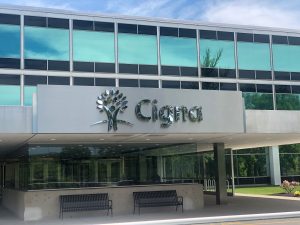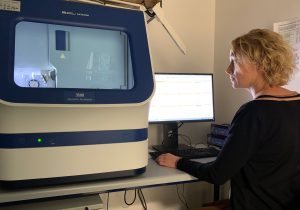
In my clinical practice, nothing has changed my work as dramatically as non-invasive prenatal testing,” says Maximilian Schmid, M.D., global head of Medical Affairs at Roche Sequencing Solutions. “It has brought genetics to the very core of clinical practice. I see it as one of the first applications of the Human Genome Project that potentially applies to everyone.”
In 2011, clinics and biotechnology companies began offering non-invasive prenatal testing (NIPT) for chromosomal aneuploidies such as trisomy 21. NIPT provides an alternative to invasive, higher-risk tests such as amniocentesis, requiring just a simple maternal blood sample to obtain cell-free DNA (cfDNA) from both mother and fetus for analysis.
Since NIPT’s debut, laboratories and testing companies have made incremental upgrades to their non-invasive screens, improving accuracy and positive predictive value. Some have also begun implementing next generation sequencing and microarray technologies to extend beyond common aneuploidies and test for sex-linked and monogenic diseases. As clinical application becomes even more widespread, researchers say major leaps forward are on the horizon, including “sequencing-free” optics-based technology and approaches that analyze whole fetal cells instead of cfDNA.
Expanding NIPT access, payer coverage
On August 12, 2020, the American College of Obstetricians and Gynecologists (ACOG) and the Society for Maternal-Fetal Medicine (SMFM) released joint guidelines recommending that prenatal screening for fetal chromosomal abnormalities be offered to all pregnant patients regardless of maternal age or baseline risk. The practice bulletin highlighted cfDNA screening as “the most sensitive and specific screening test for the common fetal aneuploidies.”
The organizations had previously recommended that all pregnant patients be offered screening for aneuploidies; however, previous guidelines only endorsed cfDNA-based NIPT for patients who were over the age of 35 or otherwise “high-risk.”
Anjali Kaimal, M.D., chair of ACOG’s committee on clinical practice guidelines for obstetrics, says, “Many babies are born to women under 35, and even though their individual risk for aneuploidy might be low, that doesn’t mean that they can’t have an affected pregnancy. The difference in this updated practice bulletin is essentially extending cell-free DNA as one of the top possible screening options that can be offered to all women. When cell-free DNA screening emerged, it was initially validated in a higher-risk population. But now there has been more data in the lower-risk population to indicate that the test is also appropriate to use in that population.”
All clinicians, academic researchers, and biotechnology executives who spoke with Clinical OMICs agree with ACOG’s recommendation to expand NIPT offerings. Many believe the change will prompt major U.S. insurance companies to reimburse NIPT more readily in a broader population.
“If the science says that NIPT is the best screening test for aneuploidy, then certainly we do a disservice to patients by making it only available to those that can afford it,” says Brynn Levy, , Ph.D., a prenatal screening expert at Columbia University Medical Center. Kaimal concurs, saying expanded insurance coverage is one of the primary concrete outcomes she and other ACOG members hope will result from the updated guidelines.

Cigna already covers NIPT at in-network labs for trisomies 13, 18, and 21 “as medically necessary,” regardless of maternal age or known risk. Aetna has not yet made any permanent policy changes expanding coverage beyond high-risk pregnancies, but a spokesperson says the new ACOG guidelines are “under review.” Other insurance companies did not respond to requests for comment.
Meghan Towne, a senior clinical affairs research specialist at Ambry Genetics, says many insurance companies have specific requirements that must be met in order to approve coverage for NIPT. These requirements can include letters of medical necessity, genetic counseling stipulations, and more. Each insurer differs, making requirements difficult to track for both clinicians and testing laboratories. “In order to really get equity across the board of what testing we can offer to patients, we need insurance companies to become more standardized,” says Towne.
Expanding the scope of NIPT
It is important to note that the ACOG’s latest practice bulletin only recommends the application of NIPT for fetal aneuploidy screening, and does not address cfDNA screening for monogenic diseases or other sequence abnormalities. Insurance coverage also generally reflects this distinction. Kaimal says these deeper genetic screens have not yet been sufficiently well-characterized for professional bodies to understand them or make recommendations.
“At this time, if there are patients who are interested in gaining information from single gene testing, microarrays, or whole exome sequencing, the test for them would be a diagnostic test,” says Kaimal, referring to invasive diagnostic tests such as amniocentesis and chorionic villus sampling.

Dennis Lo, M.D., Ph.D., winner of the 2021 Breakthrough Prize in Life Sciences for his role as one of the early pioneers of cfDNA-based NIPT, leads one of several groups that claim to have successfully completed non-invasive whole-genome sequencing with fetal cfDNA. However, he says the field is “not yet at that stage” clinically, primarily for ethical reasons.
“Our ability to curate the genome is still not perfect,” says Lo, who is a professor of chemical pathology at the Chinese University of Hong Kong. “If we sequence a whole genome, there will probably be a number of variants for which we don’t know the clinical implication. And there might also be other variants where the clinical implication won’t arise until the baby is 40 or 50 years old. And of course, by that time, medicine would be very different.”
Levy agrees that there is often an under-recognized gap between what scientists can do and what they should do. “Just because the technology is there doesn’t necessarily mean that the utility or the uptake will be as good,” he says. However, he predicts that the next major research focus in NIPT will be using NIPT to detect sequence variants that produce structural abnormalities currently detected by ultrasound. His team at Columbia has already started pursuing this angle, and plan to continue doing so in the coming years.
Accelerating development on multiple fronts
Matthew Cooper, CSO of Progenity, expects that expanded clinical application of NIPT will accelerate technological developments in the field. “More providers will sell tests in that space, and the more tests we sell and the more coverage there is, the more of those tests get paid for. That makes for a viable market, and where there’s market viability, there’s dollars for innovation,” he says.
Market research group Discovery Partners Institute estimates that the U.S. NIPT market will grow by more than $2.2 billion between 2020 and 2027, and Progenity is ready to capitalize on this growth. The company is already in the optimization phase for its latest NIPT innovation, which they have simply labeled the “Innatal 4” test. The company has thus far released very little information about the new test, but Cooper hints at a few details. Broadly, he says reducing data complexity has been one of the core goals driving the project.
“We’ve run hundreds of thousands of non-invasive prenatal tests, so we’re sitting on a mountain of data. We know exactly what parts of the genome distinguish maternal from fetal DNA,” he says. The Innatal 4 test is “sequencing-free”—a sharp contrast with almost all other tests on the market today—and will instead consist of an optics-based single molecule DNA counting assay. The test will use proprietary chemical methods to isolate and plate fetal-specific DNA segments from maternal blood samples. Those isolated segments will then be labeled with fluorescent tags. Scientists can then use standard imaging technology to quantify the fluorescent signal and examine ratios to determine the presence or absence of aneuploidies.
“I envision a future where we’ll look back on this time and think about how absurd it was to sequence so much of the genome just to distinguish between maternal and fetal signals,” says Cooper. “It’s a bit like mapping the entirety of the United States in fine detail so that you can figure out how to get to the grocery store.”
Progenity has told investors that the Innatal 4 test will deliver the same reliability while decreasing turnaround time by up to 50%. Cooper says the test also reduces cost by minimizing bioinformatics needs and relying on standard, relatively inexpensive equipment and reagents. Verification and validation tests are scheduled for 2021, with the goal of launching the product by the end of next year.

On the other end of the spectrum, some researchers seek to maximize the amount of complex, reliable fetal genetic data that can be obtained using non-invasive methods. Multiple groups—including Dutch biotech VyCAP, Danish ARCEDI Biotech, and U.S.-based Luna Genetics—are developing methods for isolating circulating trophoblasts from maternal blood samples. Isolating whole fetal cells would remove the need to distinguish between maternal and fetal DNA, and would also ensure the presence of a complete genome.
Levy, the prenatal screening expert at Columbia, says using fetal cells for NIPT would bring the tests from screening to diagnostic with regards to accuracy and positive predictive values. “It’s possible that you could have confined placental mosaicism, but that’s a caveat that we have for chorionic villus sampling now, yet we consider that to be diagnostic,” says Levy. Currently, a positive result from NIPT requires diagnostic confirmation via invasive techniques, lengthening the diagnostic process and increasing risk of miscarriage.
According to Ripudaman Singh, Ph.D., CTO at ARCEDI, his company already offers cell-based NIPT to “high-risk” pregnant patients in five different hospitals in Denmark. ARCEDI is currently in the process of launching its cell-based NIPT test on a larger scale, making it commercially available to pregnant patients “regardless of their risk-stratification.”
ARCEDI’s technology uses fetal cell-specific markers to identify placental cells known as extravillous trophoblasts. These markers allow scientists to enrich and stain cells from maternal blood samples, a process which has now been automated.
Scientists have been trying for many years to isolate circulating trophoblasts, but the cells are quite rare, making it difficult to obtain usable quantities from blood samples. Even now, says Lo, an early pioneer of NIPT, “the current generation of cell-based assays are still quite tedious.” He says steps involving microscopy tend to add an especially high amount of labor and uncertainty.
Singh admits that isolating fetal cells has been one of the most challenging steps in developing cell-based NIPT. “The difficulty in sourcing these rare cells made scientists look away to a suboptimal source of fetal genetic material, the cell-free fetal DNA. The path of fetal cells might be long, and sometimes frustrating, but the rewards are bigger,” he says. “Once that code has been cracked, the current ARCEDI technology is lean, with no human intervention in isolating fetal cells, and easy to implement in any centralized or decentralized laboratory.”
Other groups have tried different approaches to fetal cell isolation. A team at Baylor College of Medicine led by Arthur Beaudet, M.D., published a validation study of NIPT using single circulating trophoblasts in 2019. The researchers used a magnetic-activated cell sorting technique to isolate circulating placental cells. Like ARCEDI’s technology, the isolation process took advantage of fetal cell-specific antigens. However, the Baylor team’s process was not yet automated, relying instead on manual selection of cells under a microscope after staining. Beaudet recently left Baylor to cofound Luna Genetics, a Houston-based biotech developing cell-based NIPT diagnostics. He declined to comment on his research for this article.
Progenity’s Cooper is skeptical regarding the practicality of replacing cfDNA-based NIPT with cell-based. “I feel like NIPT is performing at a level where we’ve got the problem solved, so to speak,” he says. However, he remains interested in isolating fetal cells for other purposes such as monogenic disease diagnosis and carrier determination.
Levy emphasizes that new technologies require thorough validation for responsible clinical implementation, but he remains optimistic about upcoming advances in NIPT. “I think anytime we can improve patient care through new technology [it] is phenomenal,” he says.











